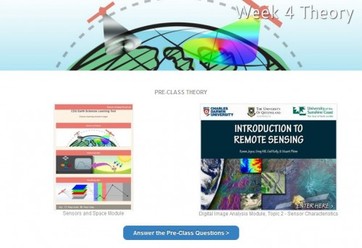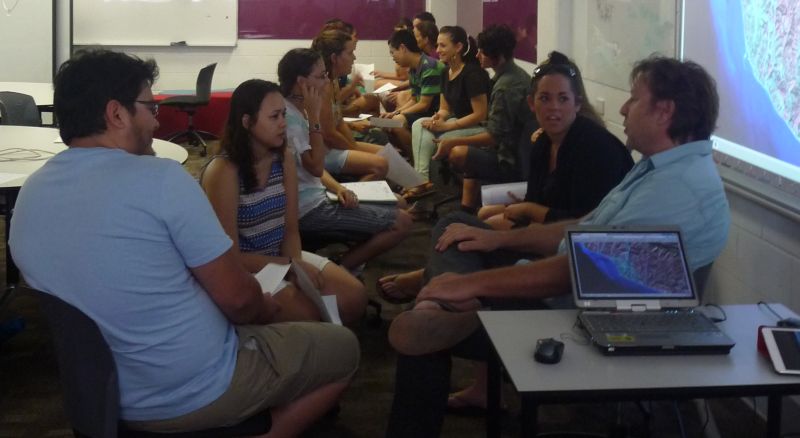Yes, the title is correct. No, it shouldn't read 'How Teaching Benefits FROM my Research'. Well, OK, it could read that way as well, it's totally a two way street. But just for now, I'll talk about one side.
I have come across many academics who see teaching as a burden that takes them away from their research. And let's be honest, sometimes the administrative overhead can be a drag. But I strongly believe that just as as teaching should be informed by research, the converse is also true.
I have been teaching in some way, shape, or form since Kindergarten. From peer tutoring to coaching sporting teams, running short courses, and university lecturing, I have done it all. I learn from those better and more experienced than me who demonstrate fantastic teaching skills. And often I learn even more from those who are lacking.
Perhaps one of the most important things that teaching has taught me, is that everything I know is something that I learned. Obvious, right? But this realisation has a big implication. What this means is that I should never take my knowledge for granted, and just assume that others know these things too. Because maybe they haven't learned them just yet. This is important when considering a target audience for a research paper or talk. Mostly they won't know all that I am going to write or say. If they did, then why am I bothering to tell them?
It's sometimes hard to remember back to a time when I didn't understand a particular basic concept in my discipline (remote sensing). It feels like common knowledge. But often these 'basic' things are really challenging for first timers. So here's the next thing that teaching has taught me - keep it simple.
One of my favourite movie quotes comes from Denzel Washington in his role as a Lawyer in Philadelphia: "Explain it to me like I'm a six year old". I consider this quote a lot in my teaching, and challenge myself to break down the most complex concepts into ideas that a child could understand.
By actively practicing simplicity in my classes, it is filtering through to other aspects of my life. And one of the major beneficiaries is my research.
I believe that simplicity is a foundation of good communication, including for research. This doesn't mean that my work needs to be 'dumbed down'. It is about engaging the audience in language that they understand. It's not about trying to impress or over-awe them with technical jargon.
I want my research to be widely read. I want my proposals to be funded. Who doesn't? Teaching - or perhaps more correctly - my students, have taught me the importance of simple language. The importance of graphics. They are my critics along with the research community and funding bodies. I have changed my research writing and presentation styles to reflect the simplicity that my students demand, and I believe (qualitatively) that I am achieving positive results.
Every week I have five hours in front of students. Granted I am not 'presenting' as such the entire time, but even so - how many other non-teaching academics get this kind of practice in public speaking or explaining concepts? Many I know might be lucky to attend one conference per year for a mere 20 minute presentation. I am certain that my improving research writing and presentation skills are primarily attributed to my teaching practice.
And of course, without teaching, there are no students. Chicken or egg? Regardless, many students look for a pathway from coursework to research. If they like my classes, they look for research projects for credit, or just as a volunteer. Either way, my own research benefits from theirs.
So research and teaching are intrinsically linked, just as they should be. I only wish that more academic staff would open their eyes to this.
I have come across many academics who see teaching as a burden that takes them away from their research. And let's be honest, sometimes the administrative overhead can be a drag. But I strongly believe that just as as teaching should be informed by research, the converse is also true.
I have been teaching in some way, shape, or form since Kindergarten. From peer tutoring to coaching sporting teams, running short courses, and university lecturing, I have done it all. I learn from those better and more experienced than me who demonstrate fantastic teaching skills. And often I learn even more from those who are lacking.
Perhaps one of the most important things that teaching has taught me, is that everything I know is something that I learned. Obvious, right? But this realisation has a big implication. What this means is that I should never take my knowledge for granted, and just assume that others know these things too. Because maybe they haven't learned them just yet. This is important when considering a target audience for a research paper or talk. Mostly they won't know all that I am going to write or say. If they did, then why am I bothering to tell them?
It's sometimes hard to remember back to a time when I didn't understand a particular basic concept in my discipline (remote sensing). It feels like common knowledge. But often these 'basic' things are really challenging for first timers. So here's the next thing that teaching has taught me - keep it simple.
One of my favourite movie quotes comes from Denzel Washington in his role as a Lawyer in Philadelphia: "Explain it to me like I'm a six year old". I consider this quote a lot in my teaching, and challenge myself to break down the most complex concepts into ideas that a child could understand.
By actively practicing simplicity in my classes, it is filtering through to other aspects of my life. And one of the major beneficiaries is my research.
I believe that simplicity is a foundation of good communication, including for research. This doesn't mean that my work needs to be 'dumbed down'. It is about engaging the audience in language that they understand. It's not about trying to impress or over-awe them with technical jargon.
I want my research to be widely read. I want my proposals to be funded. Who doesn't? Teaching - or perhaps more correctly - my students, have taught me the importance of simple language. The importance of graphics. They are my critics along with the research community and funding bodies. I have changed my research writing and presentation styles to reflect the simplicity that my students demand, and I believe (qualitatively) that I am achieving positive results.
Every week I have five hours in front of students. Granted I am not 'presenting' as such the entire time, but even so - how many other non-teaching academics get this kind of practice in public speaking or explaining concepts? Many I know might be lucky to attend one conference per year for a mere 20 minute presentation. I am certain that my improving research writing and presentation skills are primarily attributed to my teaching practice.
And of course, without teaching, there are no students. Chicken or egg? Regardless, many students look for a pathway from coursework to research. If they like my classes, they look for research projects for credit, or just as a volunteer. Either way, my own research benefits from theirs.
So research and teaching are intrinsically linked, just as they should be. I only wish that more academic staff would open their eyes to this.


 RSS Feed
RSS Feed
